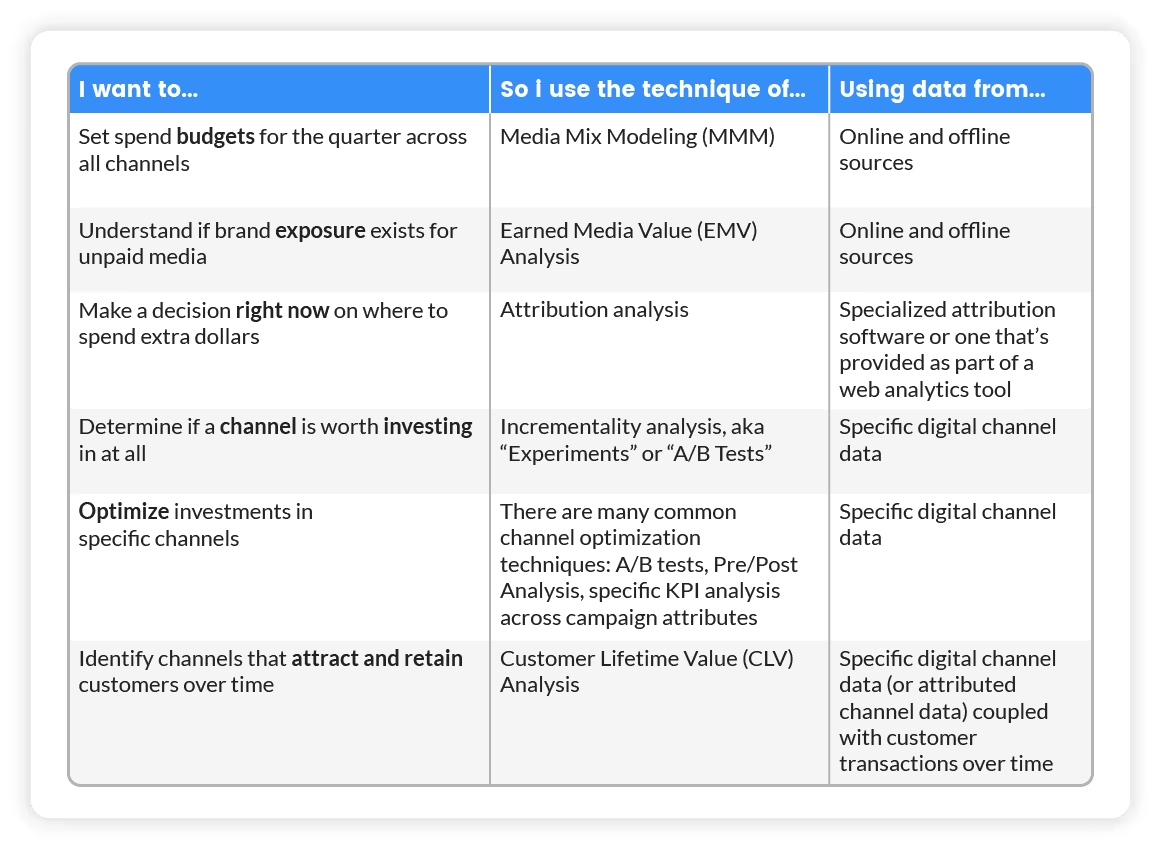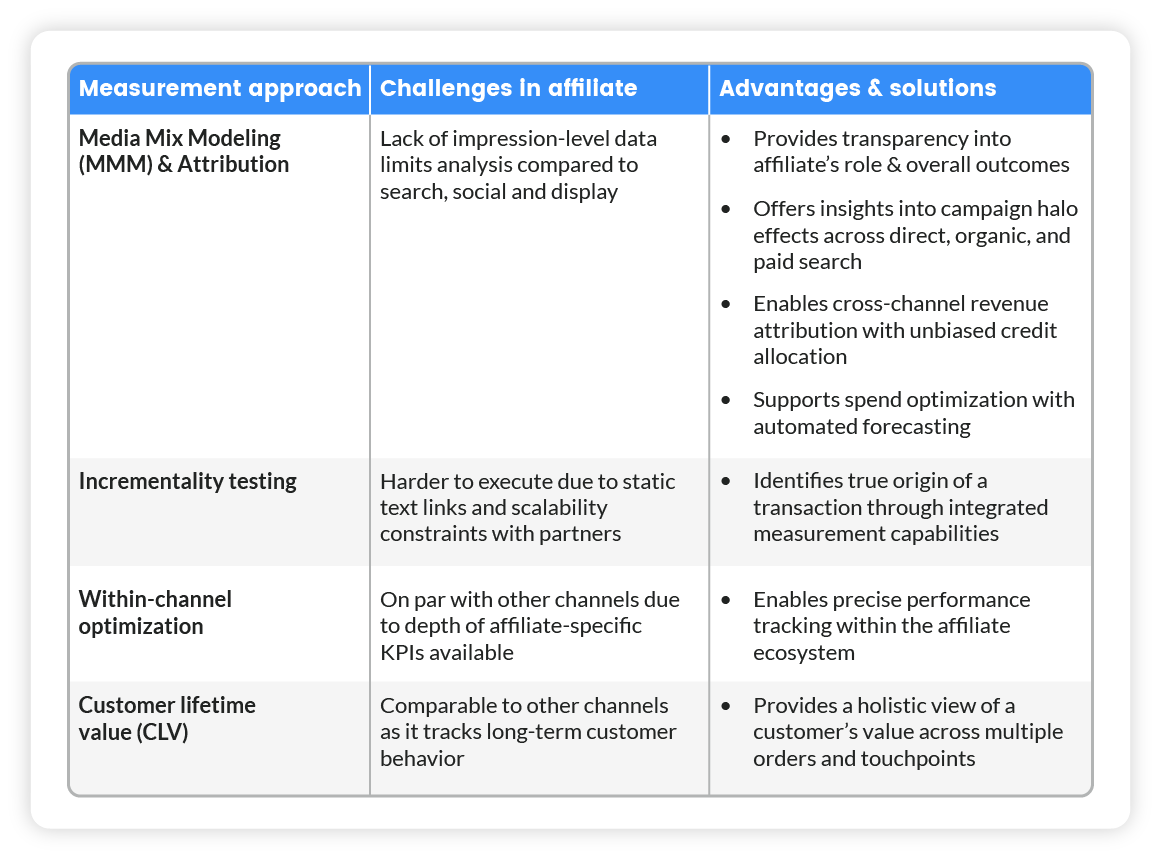Measuring marketing performance is a challenge in any channel, but the affiliate channel presents a unique set of complexities. Unlike paid search, social, display, or email—where impression tracking, attribution models, and A/B testing are well-established—affiliate marketing operates under different mechanics. This makes it harder to fit into standard measurement frameworks and explain its value within the broader marketing mix.
What do We Mean by ‘Marketing or Media Measurement’?
There are many techniques for digital marketing measurement that provide marketers with greater insights into the effectiveness and efficiency of their investments. The various techniques are used for different reasons and leverage data from a variety of sources. 

So, why is affiliate measurement so challenging, and how can brands better approach it?
Why Traditional Measurement Approaches Fall Short
Most digital marketing channels provide straightforward ways to measure effectiveness. Techniques like media mix modeling (MMM), earned media value (EMV), and attribution analysis rely on impression-level data, audience targeting, and rapid campaign controls. However, in affiliate marketing, these approaches don’t always translate.
- Impression Tracking Is Limited: Traditionally, affiliate partners have been compensated only for completed conversions, not for brand exposure or engagement along the customer journey. The affiliate channel began as a purely performance-based model, rewarding partners for sales rather than engagement. As a result, tracking impressions didn’t exist, and wasn’t worth the investment for partners.
- A/B Testing is Operationally Difficult: Unlike paid search or display, where test and control groups can be easily segmented, affiliate partners—especially content creators and deal sites—often lack the scale or tools to run controlled experiments effectively. Further, partners primarily use text link ads, which aren’t well-suited for incrementality testing or precise audience targeting. While some loyalty partners offer basic targeting, it lacks the sophistication of channels like display.
Most partners struggle to run A/B tests at scale due to resource constraints or concerns over lost revenue from control holdouts. Additionally, unlike other channels, they can’t easily pause campaigns or control spend in real-time.
For example:
-
- A travel blogger writes one article—they can’t create separate versions with and without the brand mention.
- A coupon site hosts brand-specific pages, but disabling them for a test group isn’t financially viable, as it directly affects the partner’s revenue.
- Campaigns Can’t Be Easily ‘Turned Off’: In other channels, budget allocation can be adjusted instantly. With affiliate, a blog post or coupon page remains live indefinitely, making real-time spend optimization more complex.
Where Affiliate Measurement Stands Compared to Other Channels
Despite these challenges, affiliate marketing is a valuable and growing part of the digital marketing mix. Therefore, it helps to compare affiliate measurement against other channels when assessing its performance. And while affiliate faces limitations in broader cross-channel attribution models (incrementality testing remains a bit of a challenge due to the reliance on static text links and scalability constraints, making A/B testing a bit more difficult to execute), it excels in key areas that directly impact business outcomes. For example, while affiliate still struggles with getting impression data into the media mix model (MMM), this measurement technique is very helpful in uncovering the affiliate channel’s halo effect on other channels and its impact beyond the time frame of the original campaign.
Further, within-channel optimization in affiliate marketing is as robust as other digital channels, thanks to the depth of platform-specific KPIs available. Similarly, measuring customer lifetime value (CLV) is just as effective in affiliate as it is in other channels, as it focuses on long-term customer behavior rather than just first-time conversions. Let’s take a closer look at other methods:
- Incrementality Testing: A/B tests are harder to execute in affiliate due to its reliance on static text links and the operational constraints of partners including scalability challenges that hinder A/B testing.
- Within-Channel Optimization: On par with within-channel optimization measurement given the breadth and depth of affiliate platform-specific KPIs available.
- Customer Lifetime Value (CLV): Measuring CLTV in affiliate is on par with other channels, as it looks at long-term customer behavior rather than just initial conversions, allowing for analysis across channels (channel credit tied to multiple customer orders over time).


It’s worth noting that when it comes to incrementality testing measurement, this technique overlooks the halo effect, which is the broader indirect impact of a campaign across channels. Focusing solely on direct revenue or conversions ignores factors like brand awareness, organic search traffic, and indirect conversions. When brands only focus on incrementality testing they can underestimate an affiliate campaign’s true value, as marketing efforts drive growth beyond immediate, trackable results. Our turnkey partner integrations with MMM measurement providers address this gap by providing insights into these halo effects and their financial impact.
Through these MMM measurement integrations, Partnerize advertisers can:
- Eliminate black boxes by gaining transparency into the role partnerships play in their overall outcomes and insights into campaign halo effects across direct traffic, organic search, and paid search campaigns to understand the true origin of a transaction.
- Gain a cross-channel view of revenue attribution supporting equal, unbiased credit to campaigns across digital platforms with customizable spend models unique to your brand.
- Understand the effect of marketing spend on omnichannel performance across your ecommerce site, offline sales, Amazon stores, and beyond.
- Make smarter spend allocation decisions with automated forecasting and spend optimization scenarios at the campaign level that support reaching the highest possible return on ad spend–functionality that has shown a ROAS lift of 20% or more for Partnerize clients using an integrated partner within just weeks after onboarding.
A Smarter Approach to Affiliate Measurement
While affiliate measurement differs from other channels, brands can still gain meaningful insights by adopting a tailored strategy.
- Encourage Impression Tracking: Work with partners to track impressions, and consider offering incentives for impression-based traffic they are driving to your brand, even if it’s not via a direct click.
- Leverage Independent Marketing Measurement Providers: Instead of relying on in-channel platform-owned attribution models, explore independent tools like Rockerbox, Prescient AI, Measured, or Cassandra for cross-channel insights. Given the lack of independent evaluation in these scenarios, we do not recommend using cross-channel attribution tooling from your paid channel vendors.
- Look Beyond Revenue: Evaluate multiple KPIs, rather than a singular view, such as new customer acquisition rates and repeat purchase behavior, to understand the broader value of affiliate partnerships.
Affiliate marketing continues to grow, with eMarketer projecting 11.3% growth in retail and 13.9% in non-retail affiliate-driven eCommerce sales by 2025. In summary, the affiliate channel provides significant value to brands, despite its differences from paid search, social, display, and email.
Learn more about your best approach to affiliate measurement by visiting here.